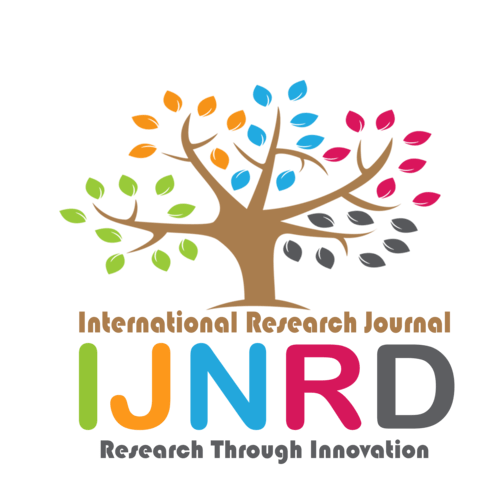|
|||||||||||||||

|
INTERNATIONAL JOURNAL OF NOVEL RESEARCH AND DEVELOPMENT International Peer Reviewed & Refereed Journals, Open Access Journal ISSN Approved Journal No: 2456-4184 | Impact factor: 8.76 | ESTD Year: 2016 Scholarly open access journals, Peer-reviewed, and Refereed Journals, Impact factor 8.76 (Calculate by google scholar and Semantic Scholar | AI-Powered Research Tool) , Multidisciplinary, Monthly, Indexing in all major database & Metadata, Citation Generator, Digital Object Identifier(DOI) |
||||||||||||||
Issue: May 2024
Volume 9 | Issue 5
Review Result and Publication of Paper within : 2-3 days
Click Here For more DetailsFor Authors
Forms / Download
Published Issue Details
Editorial Board
Other IMP Links
Facts & Figure
Impact Factor : 8.76
Issue per Year : 12
Volume Published : 9
Issue Published : 96
Article Submitted :
Article Published :
Total Authors :
Total Reviewer :
Total Countries :
Indexing Partner
Join RMS/Earn 300
Licence
This work is licensed under a Creative Commons Attribution-NonCommercial 4.0 International License







|
Published Paper Details
|
|
| Paper Title: | SPATIO-TEMPORAL ANALYSIS OF THE EFFECTS OF LAND USE CHANGE ON WETLANDS DEGRADATION IN RWANDA FROM 2000 TO 2020. THE CASE OF BAHIMBA WETLAND IN RULINDO DISTRICT |
| Authors Name: | Christelle UMWALI |
| Download E-Certificate: | Download |
| Author Reg. ID: |
IJNRD_220048
|
| Published Paper Id: | IJNRD2404791 |
| Published In: | Volume 9 Issue 4, April-2024 |
| DOI: | |
| Abstract: | The study entitled ‘Spatio-temporal Analysis of the Effects of Land Use Change on Wetland Degradation in Rwanda: A Case Study of Bahimba Wetland in Rulindo District’ aimed to achieve four specific objectives, such as to assess the dynamics of land use change in the area of Bahimba Wetland from 2000 to 2020; to investigate the major drivers of land use change in the vicinity of Bahimba Wetland and their impact on natural resources, particularly forested land; and to evaluate the level of degradation in Bahimba Wetland resulting from land use changes during the same period. The study employed a survey-based, descriptive, qualitative, and quantitative design, utilizing both primary and secondary data. Data collection methods included questionnaires, field interviews, and documentation. Data analysis involved tools such as SPSS (Statistical Package for Social Scientists) for quantitative data and GIS (Geographic Information System) tools along with Google Earth for geospatial data and for qualitative data, the study has summarized all ideas and reported in chapter four. The findings emphasized the critical role of wetlands as ecosystems that offer various benefits at local and global levels, including water quality enhancement, biodiversity support, and recreational opportunities. However, human-induced activities, particularly land use changes, often lead to wetland degradation. Understanding these impacts is crucial for informed decision-making. The study highlighted the negative consequences of losing ecosystem services value due to land use and land cover changes, affecting local climate, waste management, and community livelihoods. The study findings reveal that the model exhibited an F ratio of 10.184, with a P value less than 0.05. This indicates that the F ratio is statistically significant. Consequently, the overall regression model, encompassing all tested variables, also demonstrates statistical significance and can be employed for prediction at a 1% significance level. Furthermore, the predictor variables specifically, Land for agriculture (X1), Land Forest (X2), and Land for Builtup and bare soil (X3) are statistically significant in relation to wetland degradation (Y). These land use changes, including shifts in agriculture, forest, and built-up areas, significantly impact water pollution, soil quality, biodiversity, ecosystems, indigenous plants, and climate change. Notably, there exists a low level of awareness regarding land use policies, agricultural policies, environmental management, and natural resources management. Consequently, uncontrolled economic activities, such as constructing houses in Bahimba wetland, underscore the need for increased awareness and robust measures like wetland restoration to safeguard biodiversity, water quality, and ecosystem health. To mitigate this, interventions should prioritize wetland restoration and sustainable management, both in urban and rural contexts. Ultimately, achieving a balance between development and environmental conservation is essential, especially in wetland ecosystems. By understanding the consequences of land use changes, we can make informed decisions to protect these valuable natural resources. |
| Keywords: | Spatio-temporal analysis; Effects; Land Use Change; Climate change, Wetlands degradation; Bahimba wetland, Rwanda |
| Cite Article: | "SPATIO-TEMPORAL ANALYSIS OF THE EFFECTS OF LAND USE CHANGE ON WETLANDS DEGRADATION IN RWANDA FROM 2000 TO 2020. THE CASE OF BAHIMBA WETLAND IN RULINDO DISTRICT", International Journal of Novel Research and Development (www.ijnrd.org), ISSN:2456-4184, Vol.9, Issue 4, page no.h826-h841, April-2024, Available :http://www.ijnrd.org/papers/IJNRD2404791.pdf |
| Downloads: | 00031 |
| ISSN: |
2456-4184 | IMPACT FACTOR: 8.76 Calculated By Google Scholar| ESTD YEAR: 2016 An International Scholarly Open Access Journal, Peer-Reviewed, Refereed Journal Impact Factor 8.76 Calculate by Google Scholar and Semantic Scholar | AI-Powered Research Tool, Multidisciplinary, Monthly, Multilanguage Journal Indexing in All Major Database & Metadata, Citation Generator |
| Publication Details: |
Published Paper ID:IJNRD2404791 Registration ID: 220048 Published In: Volume 9 Issue 4, April-2024 DOI (Digital Object Identifier): Page No: h826-h841 Country: Ruyenzi Cell, Rwanda, Rwanda Research Area: Environmental Management Publisher : IJ Publication Published Paper URL : https://www.ijnrd.org/viewpaperforall?paper=IJNRD2404791 Published Paper PDF: https://www.ijnrd.org/papers/IJNRD2404791 |
| Share Article: | |
|
Click Here to Download This Article |
|
| Article Preview | |
|
|
|
Major Indexing from www.ijnrd.org
| Semantic Scholar | Microsaoft Academic | ORCID | Zenodo |
| Google Scholar | ResearcherID Thomson Reuters | Mendeley : reference manager | Academia.edu |
| arXiv.org : cornell university library | Research Gate | CiteSeerX | PUBLON |
| DRJI | SSRN | Scribd | DocStoc |
ISSN Details
 |
 |
ISSN: 2456-4184
Impact Factor: 8.76 and ISSN APPROVED
Journal Starting Year (ESTD) : 2016
DOI (A digital object identifier)
Conference
Open Access License Policy
Important Details
Social Media
| Copyright © 2024 - All Rights Reserved - IJNRD |












Facebook Twitter Instagram LinkedIn